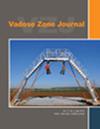Improving evapotranspiration computation with electrical resistivity tomography in a maize field
IF 2.8
3区 地球科学
Q3 ENVIRONMENTAL SCIENCES
引用次数: 0
Abstract
Hydrogeophysical methods have been increasingly used to study subsurface soil–water dynamics, yet their application beyond the soil compartment or the quantitative link to soil hydraulic properties remains limited. To examine how these methods can inform model-based evapotranspiration (ET) calculation under varying soil water conditions, we conducted a pilot-scale field study at an experimental maize plot with manipulated irrigation treatments. Our goal was to develop a workflow for (1) acquiring and inverting field electrical resistivity tomography (ERT) data, (2) correlating ERT to soil hydraulic properties, (3) spatially characterizing soil water stress that feeds into ET modeling (the FAO-56 model), and (4) evaluating the performance of ERT-based ET computation. Our results showed that ERT was able to capture decimeter-scale soil water content (SWC) dynamics from root water uptake and irrigation manipulation and the contrast of soil water stress between deficiently and fully irrigated maize. We also demonstrated the flexibility of using ERT to spatially integrate soil water stress in the soil volume of interest, which could be adjusted based on different crops and plot layouts. The integration of the ERT datasets into ET modeling provided insights into the spatial heterogeneity of the subsurface that has been challenging for point-based sensing, which can further our understanding of the hydraulic dynamics in the soil-plant-atmosphere continuum.利用电阻率层析成像技术改进玉米田蒸散发计算
水地球物理方法越来越多地用于研究地下土壤-水动力学,但其在土壤隔室之外的应用或与土壤水力特性的定量联系仍然有限。为了研究这些方法如何在不同土壤水分条件下为基于模型的蒸散发(ET)计算提供信息,我们在一个试验田进行了中试规模的田间研究,并进行了操纵灌溉处理。我们的目标是开发一个工作流程:(1)获取和反演场电阻率层析成像(ERT)数据,(2)将ERT与土壤水力特性相关联,(3)将土壤水分应力的空间特征用于ET建模(FAO-56模型),以及(4)评估基于ERT的ET计算的性能。结果表明,ERT能够从根系水分吸收和灌溉操作中捕捉到分米尺度的土壤水分动态,以及缺水和充分灌溉玉米土壤水分胁迫的对比。我们还展示了利用ERT在感兴趣的土壤体积中空间整合土壤水分胁迫的灵活性,可以根据不同的作物和地块布局进行调整。将ERT数据集整合到ET建模中,可以深入了解地下的空间异质性,这对基于点的遥感来说是一个挑战,可以进一步了解土壤-植物-大气连续体中的水力动力学。
本文章由计算机程序翻译,如有差异,请以英文原文为准。
求助全文
约1分钟内获得全文
求助全文
来源期刊

Vadose Zone Journal
环境科学-环境科学
CiteScore
5.60
自引率
7.10%
发文量
61
审稿时长
3.8 months
期刊介绍:
Vadose Zone Journal is a unique publication outlet for interdisciplinary research and assessment of the vadose zone, the portion of the Critical Zone that comprises the Earth’s critical living surface down to groundwater. It is a peer-reviewed, international journal publishing reviews, original research, and special sections across a wide range of disciplines. Vadose Zone Journal reports fundamental and applied research from disciplinary and multidisciplinary investigations, including assessment and policy analyses, of the mostly unsaturated zone between the soil surface and the groundwater table. The goal is to disseminate information to facilitate science-based decision-making and sustainable management of the vadose zone. Examples of topic areas suitable for VZJ are variably saturated fluid flow, heat and solute transport in granular and fractured media, flow processes in the capillary fringe at or near the water table, water table management, regional and global climate change impacts on the vadose zone, carbon sequestration, design and performance of waste disposal facilities, long-term stewardship of contaminated sites in the vadose zone, biogeochemical transformation processes, microbial processes in shallow and deep formations, bioremediation, and the fate and transport of radionuclides, inorganic and organic chemicals, colloids, viruses, and microorganisms. Articles in VZJ also address yet-to-be-resolved issues, such as how to quantify heterogeneity of subsurface processes and properties, and how to couple physical, chemical, and biological processes across a range of spatial scales from the molecular to the global.
 求助内容:
求助内容: 应助结果提醒方式:
应助结果提醒方式:


